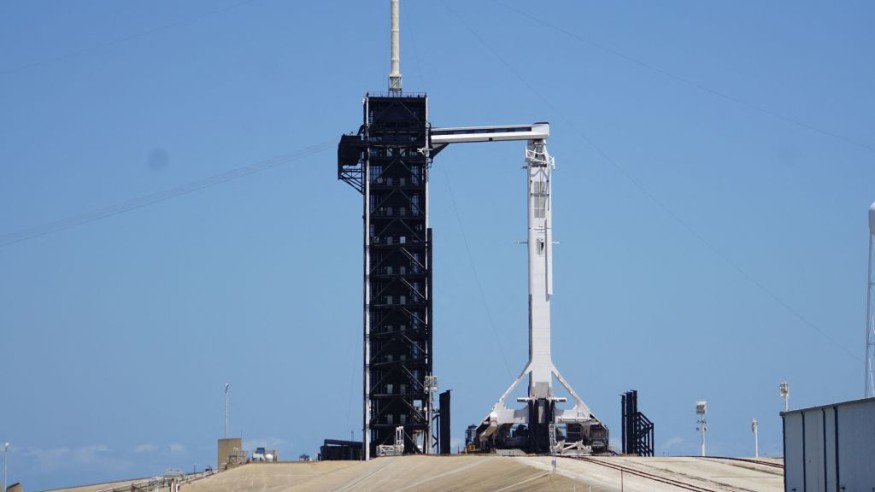SpaceX launched its second rocket of the week on Wednesday, February 2, from the Vandenberg Space Force Base on California's Central Coast, launching a secret satellite into orbit.
At 3:27 p.m. EST, the Falcon 9 rocket launched into bright blue skies above Southern California, carrying a satellite for the U.S. National Reconnaissance Office.
The first stage of the Falcon 9 rocket landed back at Vandenberg about 10 minutes after launch, allowing it to be reused in future flights and lower flying costs.
The launch was the second of three scheduled by SpaceX this week. On Monday, the firm launched COSMO-SkyMed Second Generation FM2, an Italian Earth-observation satellite, from Cape Canaveral in Florida.
SpaceX live-streamed the trip as usual. But because of the payload's secret nature, Digital Trends said the private spaceflight corporation did not provide footage of the satellite's release into orbit.

SpaceX Falcon 9 rocket, seen on the launch pad at Launch Complex 39A less that 24 hours before it is scheduled to launch for its Crew-2 mission, at NASAs Kennedy Space Center in Florida, April 22, 2021. - A crewed SpaceX mission to the International Space Station has been postponed by a day due to weather concerns downrange of the launch site, NASA said Wednesday. Liftoff had been scheduled for Thursday but because of unfavorable conditions along the Atlantic coast, it will now be set for 5:49 am (0949 GMT) Friday April 23.
SpaceX Falcon 9 Rocket Launches US Military Spy Satellite
The payload on onboard 229-foot-tall (70-meter) rocket was for the National Reconnaissance Office, which is in charge of the government's fleet of spy satellites that map the Earth with optical and radar images, monitor foreign adversary communications, and follow worldwide naval operations.
SpaceX Falcon 9 rocket took off from Vandenberg, California, on the Pacific coast between Los Angeles and San Francisco, and flew through the atmosphere in just a few minutes.
Liftoff! pic.twitter.com/pvsB7IqKSj
— SpaceX (@SpaceX) February 2, 2022
After about two and a half minutes of fire, the rocket's first stage shut down and separated. Three Merlin engines on the booster stage fired to return the rocket to Vandenberg, while the Falcon 9's second stage engine continued to accelerate the rocket into orbit.
ALSO READ : Falcon 9 Rocket's Second Stage Will Likely Impact Moon's Equator After 7 Years of Floating Through Space
SpaceFlightNow said the 16-story booster stage flew in an arc to a peak height of 144 kilometers (89 miles) before plummeting back to Earth. It landed vertically at Vandenberg utilizing hypersonic grid fins and engine burns. Four legs emerged from the rocket's base as it landed a quarter-mile from the mission's launch pad in Landing Zone 4, SpaceX's West Coast landing site.
Falcon 9’s first stage has landed pic.twitter.com/E22NvEiKe0
— SpaceX (@SpaceX) February 2, 2022
SpaceX's live webcast monitored the rocket's fall and landing with onboard camera images. Nearly three minutes into the flight, the payload fairing separated from the upper stage, revealing the secret NRO cargo after reaching orbit.
However, reports on the upper stage's development were stopped there at the request of the NRO, which keeps its missions hidden for national security reasons.
The upper stage was planned to fire for around six minutes to deliver the NRO payload into a preliminary orbit. After the rocket traveled halfway around the world, a second fire was scheduled, setting the stage for deploying the top-secret spy spacecraft.
All of those accomplishments, however, took place behind closed doors. The National Reconnaissance Office deemed the operation, codenamed NROL-87, a success two hours after launch.
About NROL-87
Los Angeles Times said the NROL-87 satellite was only characterized as a "national security payload" by The National Reconnaissance Office (NRO). It was one of three launches granted to SpaceX by the Air Force in 2019 for a total fixed price of $297 million.
NRO is the federal agency in charge of developing, producing, launching, and managing U.S. satellites that deliver intelligence data to top policymakers, the intelligence community, and the Department of Defense.
This year, the office intends to launch almost a dozen payloads into space with more than a half-dozen missions. Last year, NROL-82 from Vandenberg and NROL-111 from NASA's Wallops Flight Facility in Virginia launched two NROs.
RELATED ARTICLE : SpaceX Wants to Launch Rockets Weekly to Achieve Elon Musk's Goal of Having 52 Missions in 2022
Check out more news and information on SpaceX in Science Times.
© 2025 ScienceTimes.com All rights reserved. Do not reproduce without permission. The window to the world of Science Times.












